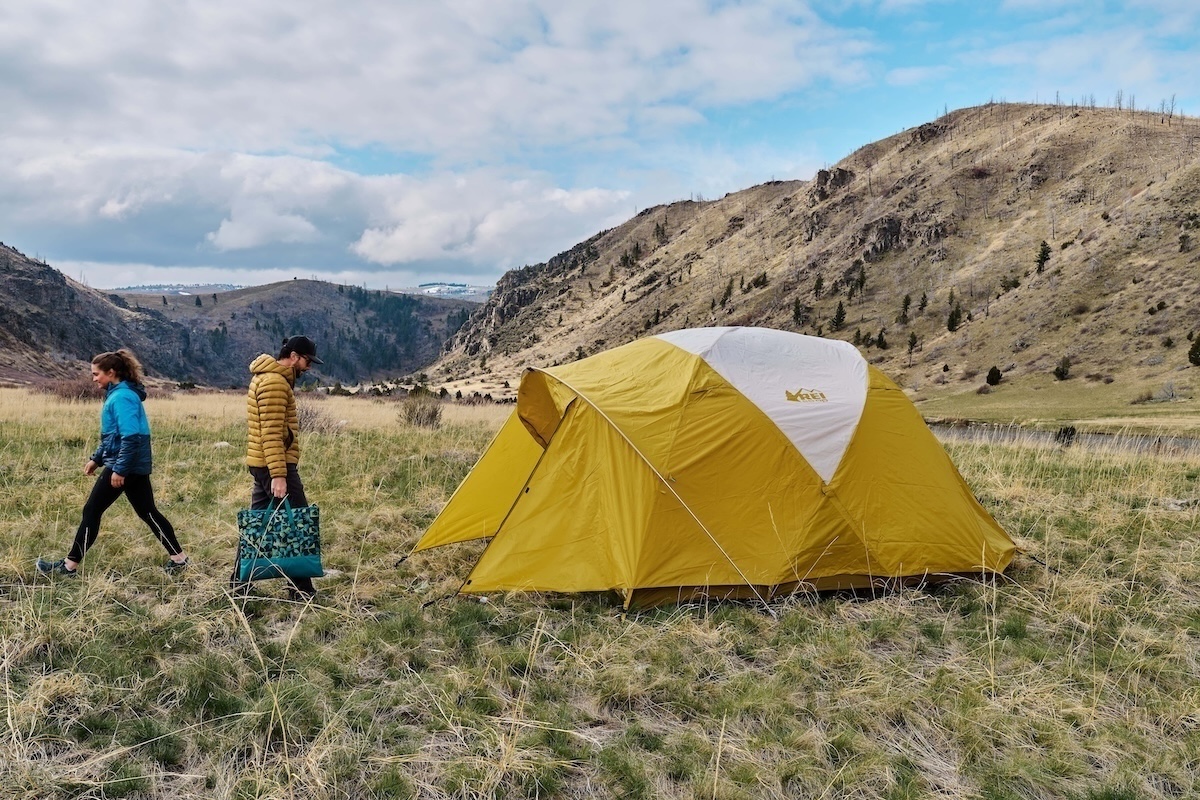
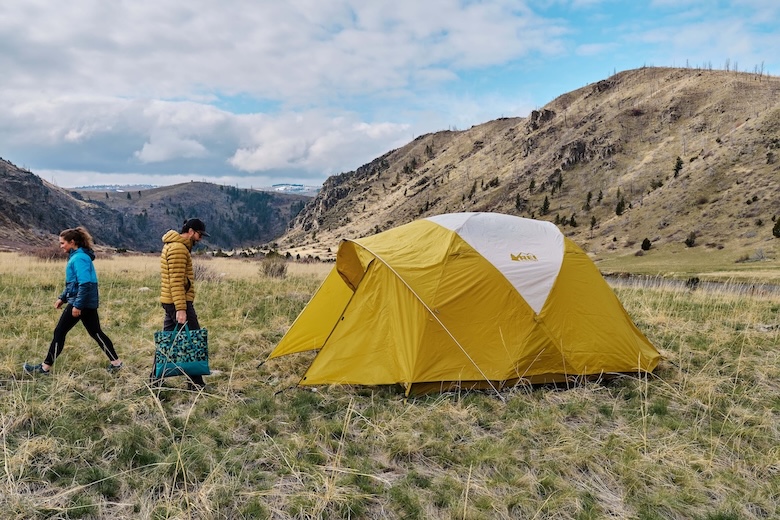
Price: $549
Floor area: 84 sq. ft.
Doors: 2
Weight: 20 lbs. 11.5 oz.
Capacities: 4P, 6P
What we like: Sturdy structure, ease of use, and full-coverage rainfly.
What we don't: Interior isn't as roomy as REI's Wonderland; mediocre ventilation.
See the REI Co-op Base Camp 6
Featuring high-quality materials and a traditional dome shape, REI Co-op’s Base Camp has been a long-time staple in their tent lineup. Offered in four- and six-person capacities, the car camping-focused model is a top choice among those looking to balance a roomy interior with solid weather protection. In testing the Base Camp 6, we were impressed by its sturdiness in foul conditions, durable materials, and generous interior and exterior storage. Below we break down our experiences with the Base Camp 6. To see how it stacks up to the competition, see our article on the best camping tents.
Editor's note: We updated this guide on June 5, 2025 to reflect our experience with the most up-to-date version of the Base Camp 6. Updates below include a new section highlighting the tent’s latest sustainability improvements, new photos illustrating the current model, and a thorough review to ensure all information about the prior version that we carried over was still accurate and true to our experience with the latest version.
With its dome-like shape, two large doors, and 74-inch peak height, REI’s Base Camp 6 provides ample living space. While it can’t quite compete with REI’s more upright and cavernous Wonderland 6, the crisscrossing five pole design does a nice job stretching the walls up and away from you. There’s sufficient space for multiple campers to move around, and at 5’9", one of our testers was easily able to stand up in the middle of the tent. That said, his outstretched arms could touch both walls when doing so—something that’s not possible in the Wonderland. In terms of sleeping, the square floor dimensions (110 x 110 in.) are a bit crammed in our opinion, as six standard 20-inch sleeping pads don’t fit side-by-side (five will barely fit, and the sixth would need to sleep perpendicularly at the head or foot end).
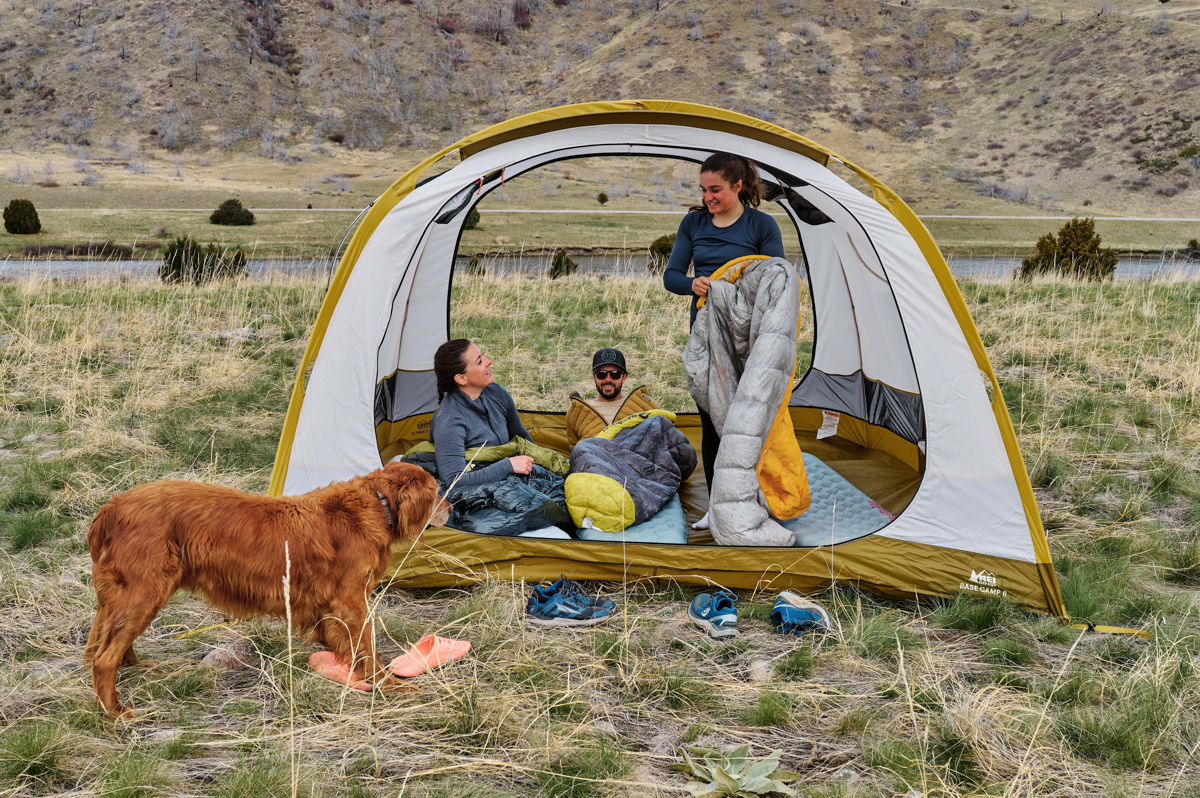
As is the case with nearly all camping tents, we think sizing up in terms of capacity is a good idea. Even with smaller kids, the Base Camp 6 is best suited for groups of three or four. This allows for plenty of room to spread out while sleeping, and gives enough cushion for wider pads or mattresses, while leaving enough space to change and move around during the day. For smaller groups in the two to three range, REI also makes the Base Camp 4.
If wind and wet weather protection are near the top of your list of must-haves, then we think the Base Camp 6 is a great choice. Its pole design resembles a mountaineering tent—albeit a taller and toned-down version—the rainfly extends all the way to the ground and completely covers the doors, and its seam sealing has held up without issue. Plus, both the canopy and rainfly are outfitted with a PFAS-free durable water repellent (DWR) coating that sheds moisture. While we haven’t experienced any gale-force winds in the Base Camp, we can attest that it remains stable in gusts of around 20 miles per hour when properly anchored down (guylines are included, but you’ll need to purchase additional stakes to use them). All in all, REI’s Base Camp is properly equipped for foul-weather camping. But as we alluded to above, if you don’t need the extra wind and rain protection, we think you’ll be better served by the more livable and slightly less weatherproof Wonderland series.
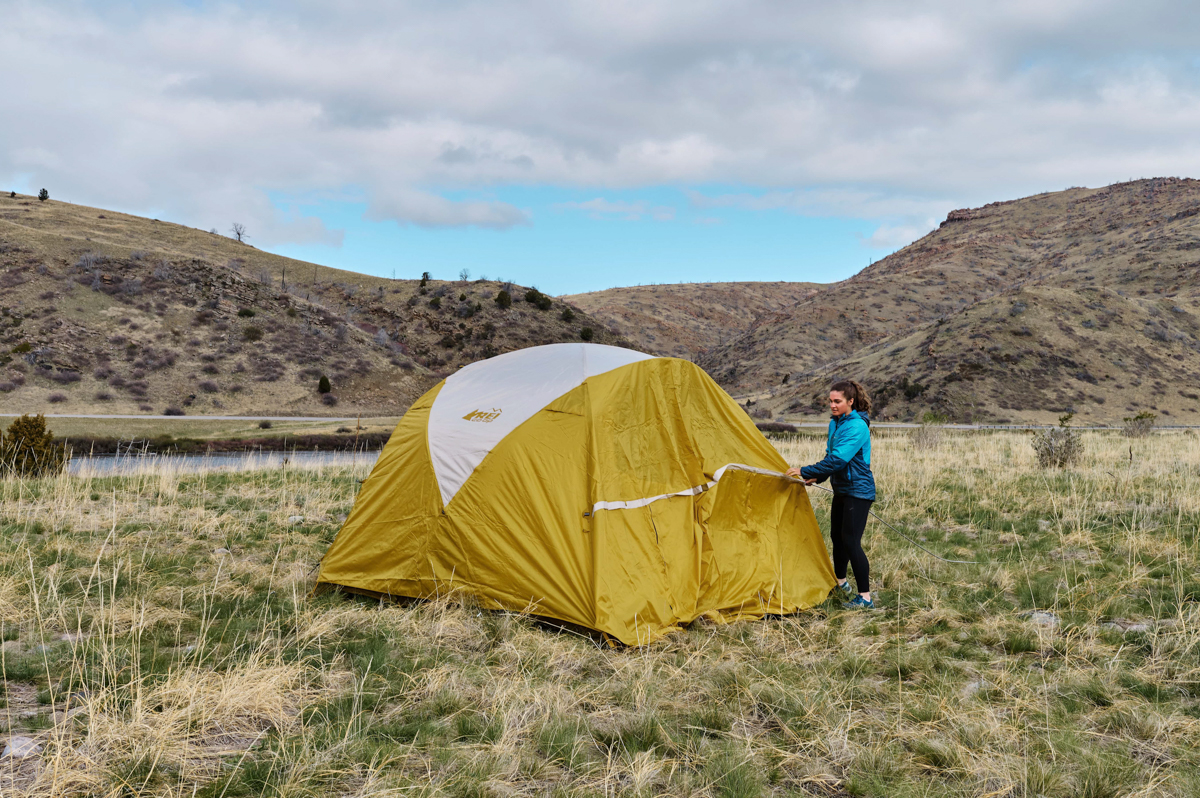
With a strong emphasis on sealing out wind and rain and less on maximizing airflow, we found the Base Camp is only a mediocre ventilator. Even with the partial mesh doors open, rainfly vents propped up, and floor vents unzipped, the Base Camp 6 simply can’t compete with a mesh-heavy design. It certainly does the trick in moderate temperatures, but the solid fabric side walls and full-coverage rainfly limit air circulation. The Marmot Limestone beats the Base Camp fairly easily in this respect. The Marmot has a healthy dose of mesh on the front door, sides, and roof—all of which help to keep air moving on muggy nights.
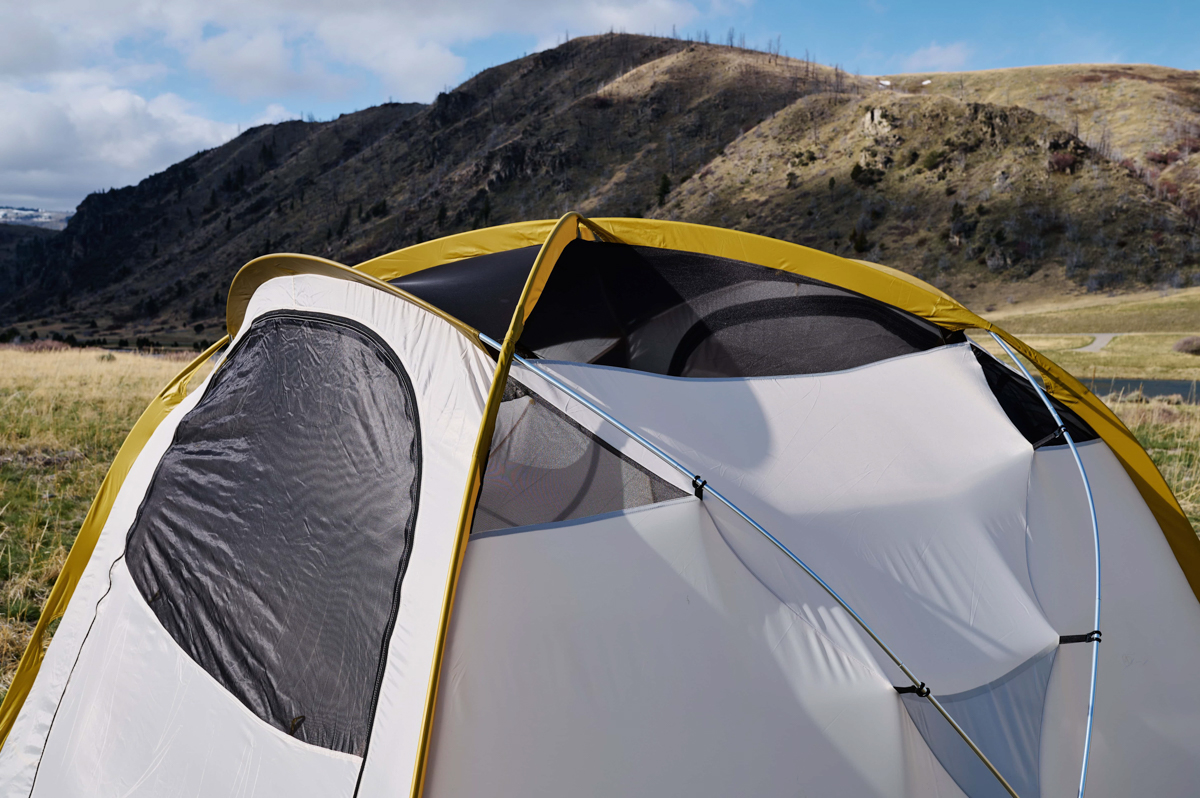
Proper organization is important for successful car camping adventures, and we’re pleased to report that the Base Camp 6 has plenty of storage. A grand total of 14 conveniently placed pockets adorn the inside of the tent. The lower eight are large in nature and a great place to stash extra layers like a puffy, while two smaller mid-height options are perfect for keys and a phone. You’ll also find overhead pockets at either end of the tent for storing the doors when they’re completely unzipped. Overall, the Base Camp 6 is a well-thought-out tent in terms of interior organization.
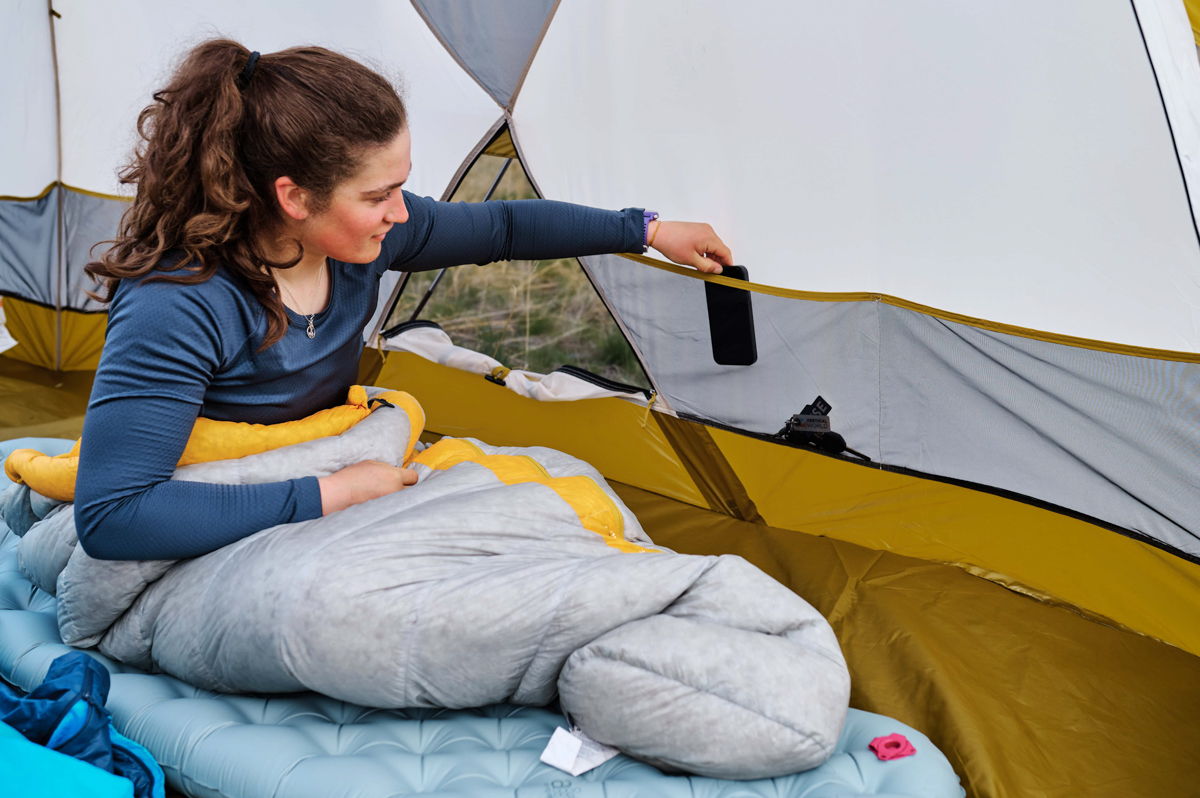
For the exterior, the Base Camp 6 features two large vestibules that provide ample storage space for items such as camp chairs or a table that require protection from the elements. The combined 44 square feet of space is quite impressive for a camping tent, and we like the fact that they have large zippered openings for easy entry and exit. For even more covered space, the Base Camp 6 is compatible with REI’s Vehicle Connector ($199), which creates a sheltered area between the tent and the back of your car. This add-on comfortably fits four camping chairs and includes additional mesh pockets for organizing gear.
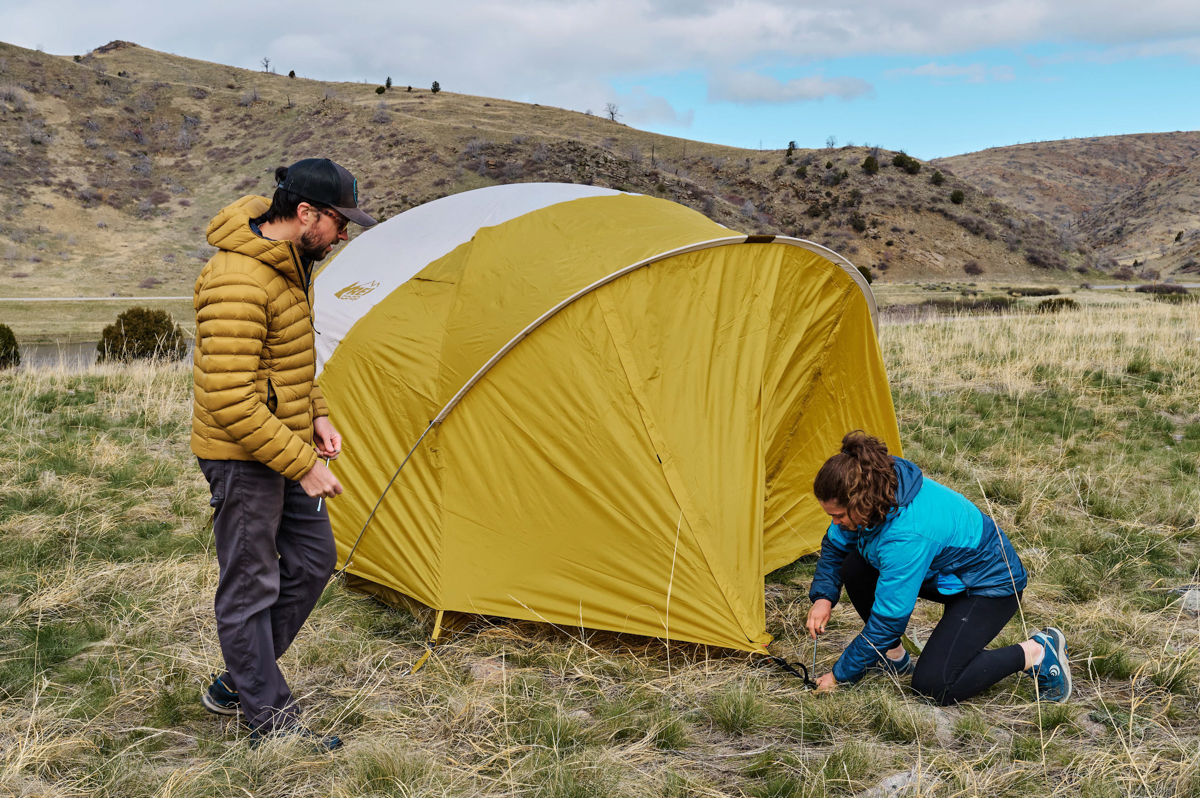
When setting up the Base Camp 6 for the first time, it was immediately clear that high-quality materials were used throughout. The thick aluminum poles are sturdy, the substantial 75-denier fabric on the rainfly and tent body is confidence-inspiring, and the stitching looks top-notch. Oftentimes it’s easy to find errors or small manufacturing defects in outdoor gear, but this is not the case with the Base Camp. Perhaps best of all, the 150-denier floor feels more like a tarp (in a good way) and means you won’t necessarily need a footprint (using one is never a bad idea, however, to extend its lifespan). Overall, we think the build quality matches the big $549 price tag, and we expect the Base Camp to hold up nicely over the long haul.
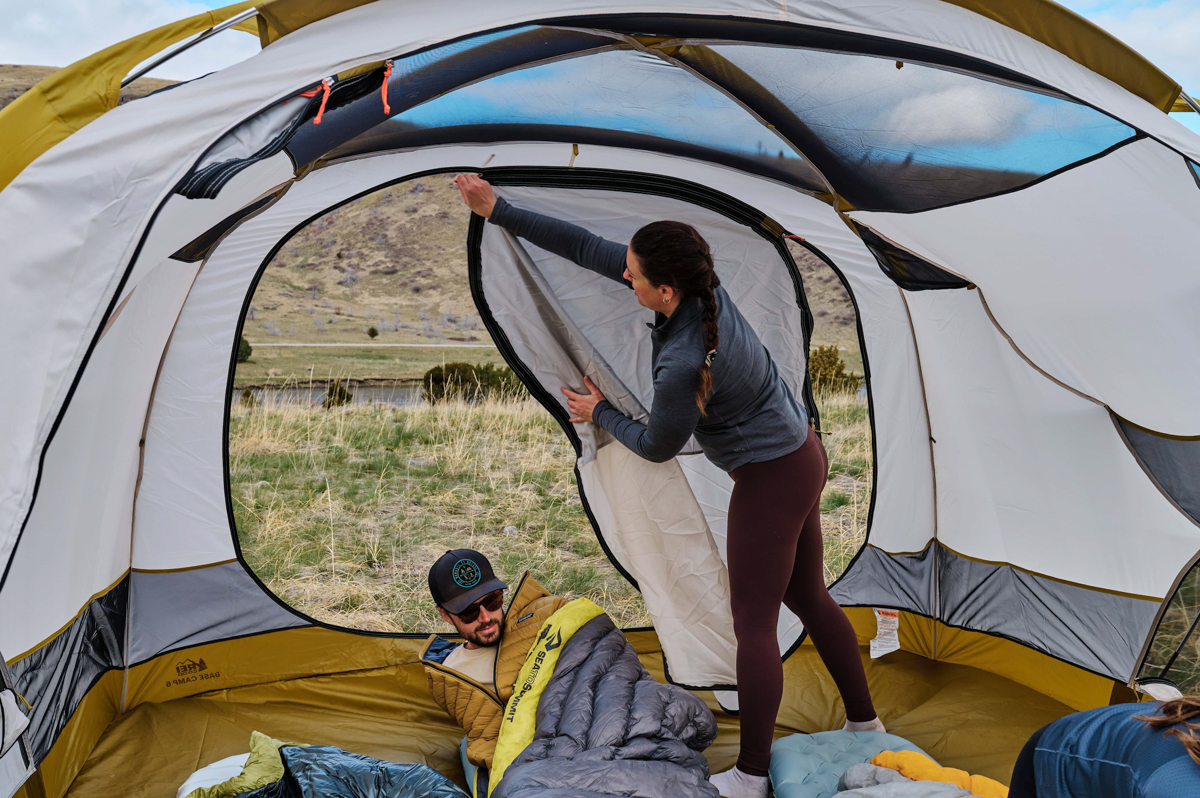
If you have dreams of setting up the ultimate backcountry base camp with this tent, we’ll just stop you right there. Tipping the scales at 20 pounds 11.5 ounces, the “6” is a beast to pack and carry around. That said, the Base Camp falls mid-pack compared with other premium car camping designs. Alternatives like the massive REI Wonderland 6 (22 lb. 15 oz.) weigh more, while Marmot’s Limestone 6 model undercuts it slightly at 15 pounds 12.7 ounces.
Regarding the included carry bag, its simple tube-like shape and shoulder strap make it fairly easy to haul to and from a vehicle. Having said that, two things would have made packing up the tent a better experience. One, its relatively small size requires careful and precise folding and rolling to make everything fit. And two, internal dividers would be nice for separating and organizing the rainfly, tent body, poles, and stakes. In our opinion, REI should have used their backpack-style Wonderland storage bag for the Base Camp, as it addresses these two main issues.
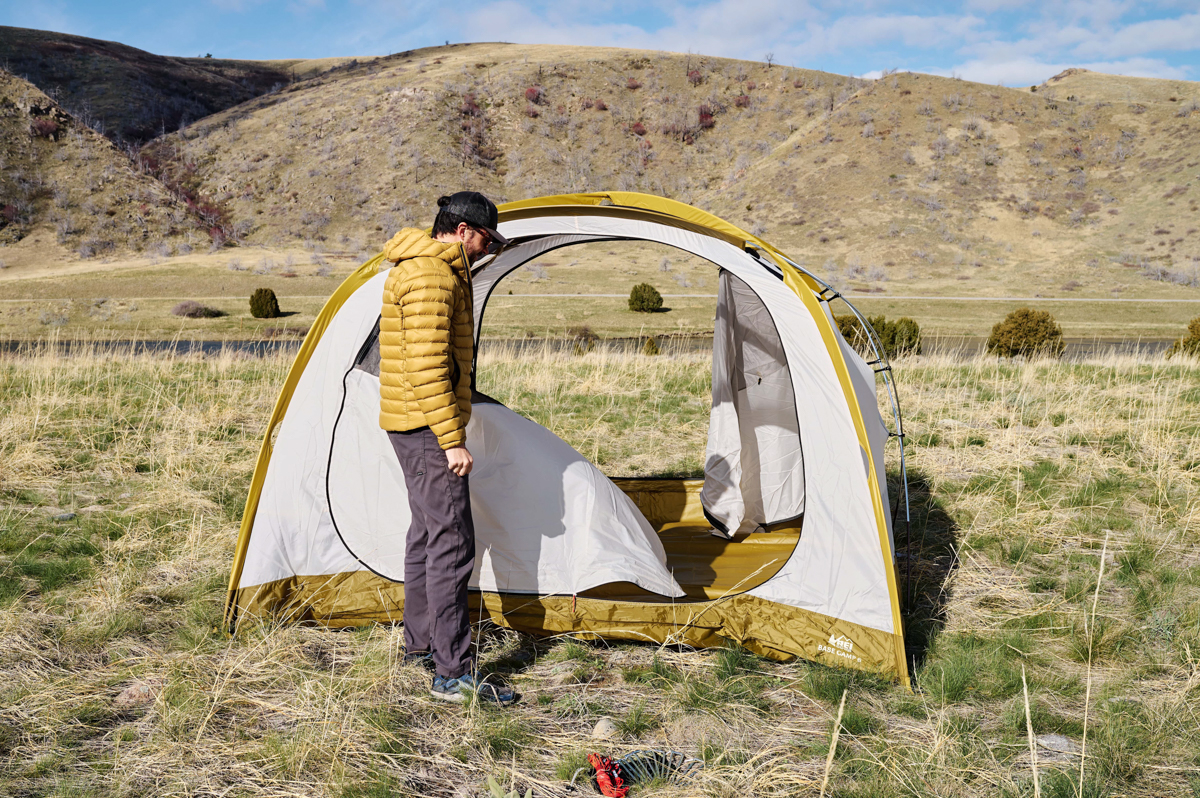
Among large, six-person camping tents, the Base Camp 6 is one of the easiest and most intuitive to set up. Its poles, sleeves, and webbing are color-coded, which means all you have to do is match them and clip everything together. As with pitching most large tents, we think it’s best done in pairs—and it never hurts to do a test run in your backyard before heading out—but even solo, the Base Camp only takes about 10 minutes. However, our recent testing revealed that pitching this tent in windy conditions can be challenging. The fabric catches gusts easily, making the setup feel like wrestling a kite to the ground, even with two people. In our opinion, replacing the pole sleeves with clips would make it easier to manage in the wind, though this isn't a dealbreaker. And it’s worth noting that REI has attached detailed setup instructions on the stuff sack, which serves as a nice refresher if you haven’t used the tent in a while.
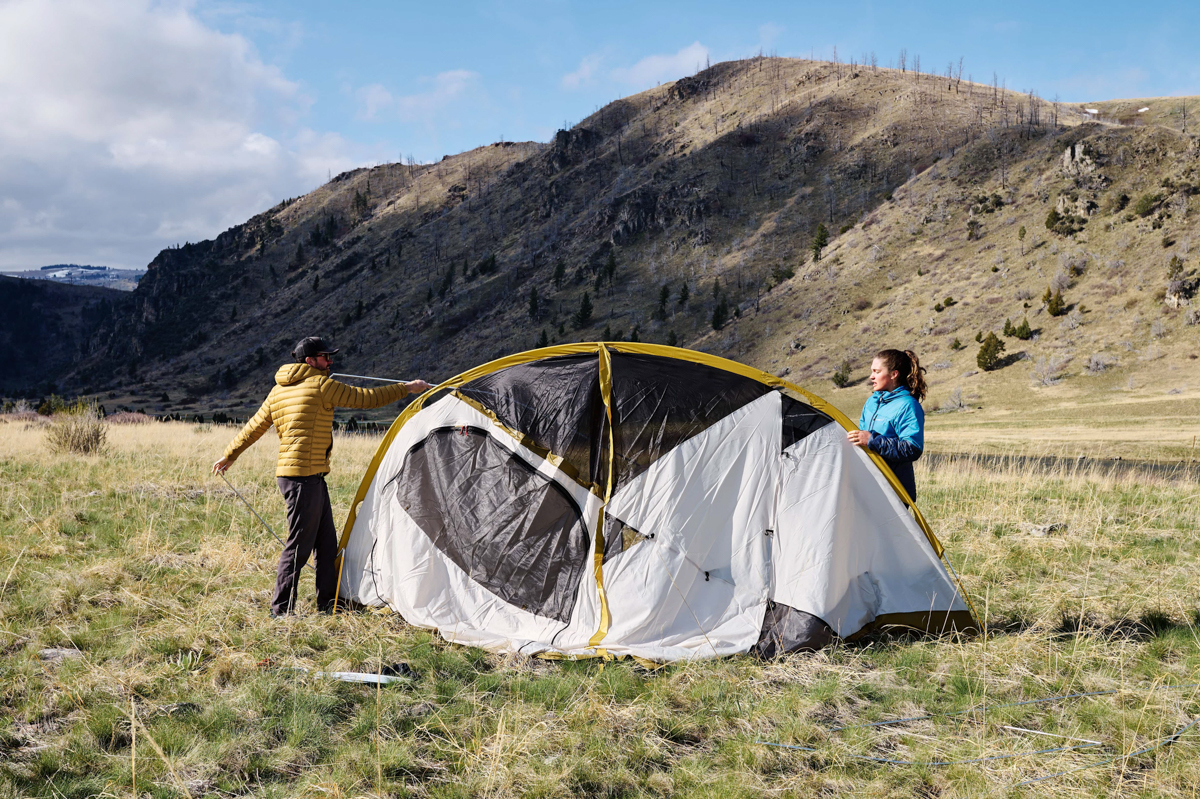
The REI Co-op has long been a leader in promoting sustainable manufacturing within the outdoor gear industry, and the latest update to the Base Camp 6 reflects that commitment. Most notably, the durable water repellent (DWR) coating on the canopy and rainfly is now PFAS-free, eliminating harmful perfluorocarbons (also known as “forever chemicals”). Additionally, the tent’s mesh is now solution-dyed, a process that significantly reduces water and energy use compared to traditional dyeing methods. Both updates align with REI’s broader goals to reduce their environmental footprint and lower carbon emissions.
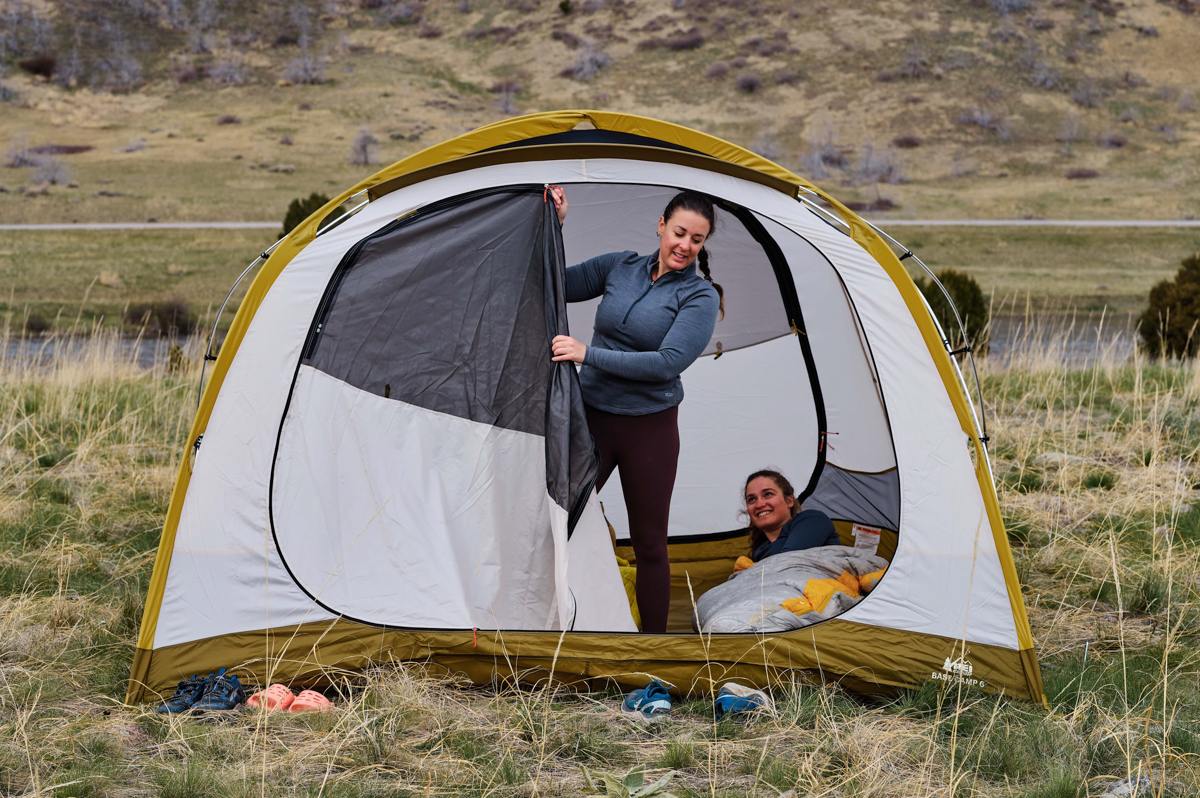
We tested the six-person version of the Base Camp for this review, but REI also offers a four-person model for $474. Overall, we think the “6” is the better choice for most campers and is an ideal size for groups of three to four people. This allows for ample room to sleep, while leaving enough space to move around during the day without the need to stack sleeping pads and bags. For smaller parties of two or three, or those needing to limit their footprint size, the Base Camp 4 is a viable option (its floor area is 100 x 86 in. and peak height is shorter at 63 in.). But in most cases, we think it’s well worth erring on the side of a little extra room. There’s a reason six-person models are consistently the biggest sellers among car camping designs.
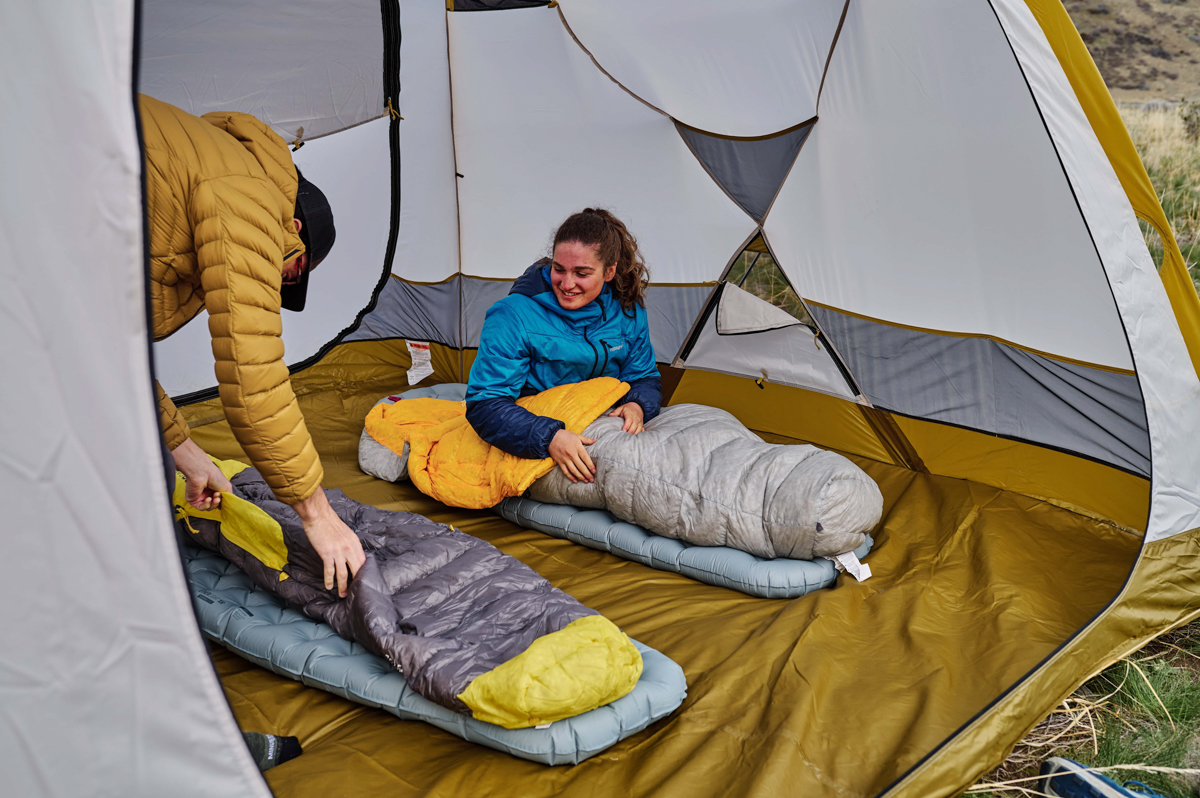

| Tent | Price | Floor Area | Doors | Weight | Height | Capacities |
|---|---|---|---|---|---|---|
| REI Co-op Base Camp 6 | $549 | 84 sq. ft. | 2 | 20 lb. 11.5 oz. | 74 in. | 4P, 6P |
| REI Co-op Wonderland 6 | $500 | 83.3 sq. ft. | 2 | 22 lb. 15.0 oz. | 78 in. | 4P, 6P |
| Marmot Limestone 6 | $529 | 82.9 sq. ft. | 2 | 15 lb. 12.7 oz. | 76 in. | 4P, 6P |
| Big Agnes Big House 6 | $600 | 89 sq. ft. | 2 | 16 lb. 1.0 oz. | 80 in. | 4P, 6P |
The REI Co-op Base Camp 6 impressed us with its foul-weather performance, stout design, and quality materials, but there are plenty of formidable competitors. In fact, one of the best models out there comes in-house in the form of REI’s Wonderland 6. The Wonderland’s tunnel-like shape, larger footprint, and more vertical walls make it noticeably more livable compared with the Base Camp. Furthermore, the generous use of mesh and modular rainfly on the Wonderland promotes a lot of airflow and makes it a better choice for warm summer camping trips. And the Wonderland has a number of aftermarket accessories, like the Mud Room, that increase both storage space and versatility (for more, see our in-depth Wonderland 4 review). In the end, unless you need the Base Camp’s superior weather protection—the upright Wonderland struggles in heavy wind—we give the nod to the Wonderland’s more open layout.
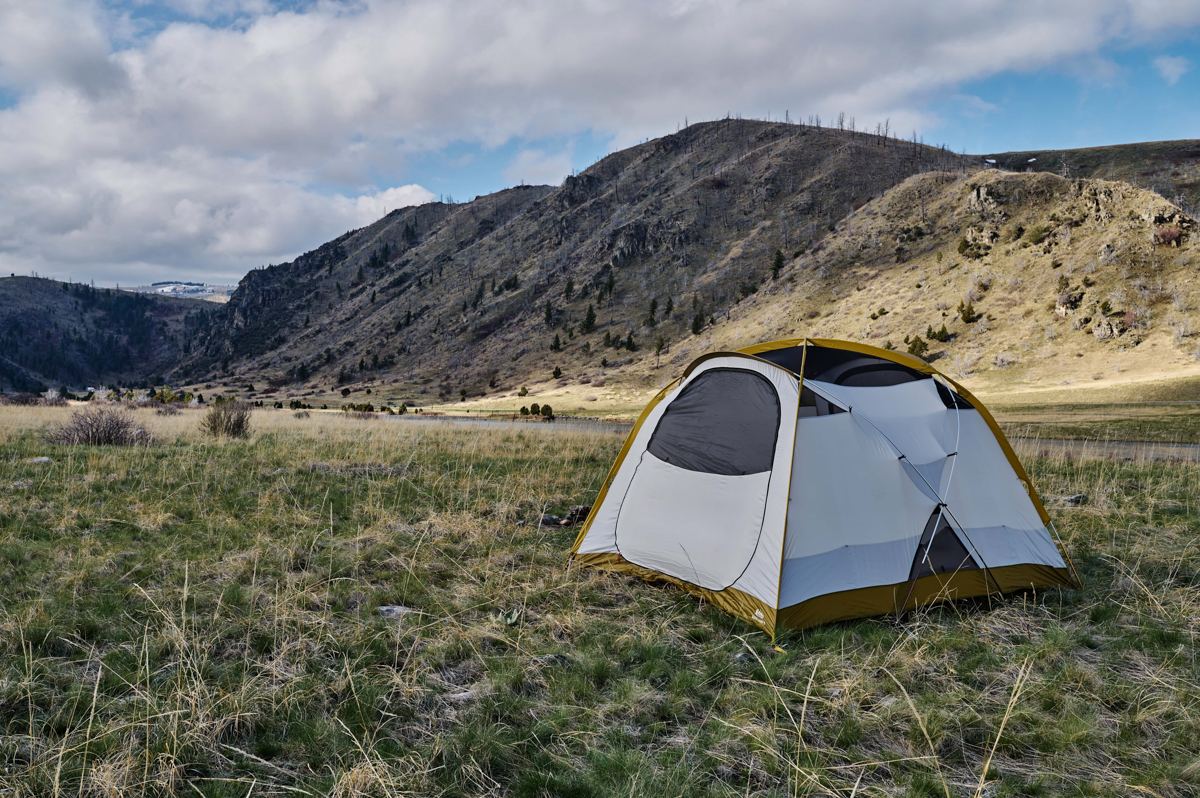
Another popular option is Marmot’s Limestone series. Like the Base Camp, it’s also made in four- and six-person capacities and utilizes a dome-like shape. But with pre-bent poles and a unique halo-like structure along the sides of the roof, the Marmot has a more expansive interior. Additionally, the heavy use of mesh on the Limestone results in superior ventilation. And the rectangular floor dimensions of the six-person Limestone (120 x 100 in.) are easier for fitting six 20-inch pads in a pinch (the Base Camp is 110 x 110 in.). Where the Base Camp gets the edge is vestibule space (44 sq. ft. vs. 40.9 sq. ft) and weather protection with its stronger pole structure.
Lastly, Big Agnes’ Big House 6 is another impressively livable tent at a good price. The Big House is a bit larger than Base Camp with 89 square feet of floor area, and the 80-inch peak height and near-vertical walls open up in the interior in a big way. That said, the taller build isn’t nearly as stable in strong winds, and the included rainfly doesn’t cover the front door (you can buy an accessory vestibule separately). Added up, the Big Agnes is much less weather-resistant than the REI. It’s still a viable option for those who camp in mild conditions, but the Base Camp wins out as the more versatile overall design.
Back to the REI Co-op Base Camp 6 See Our Camping Tent Review